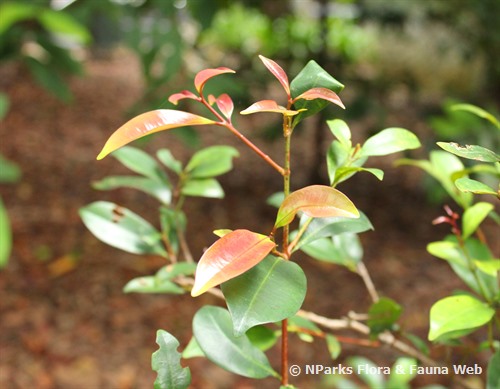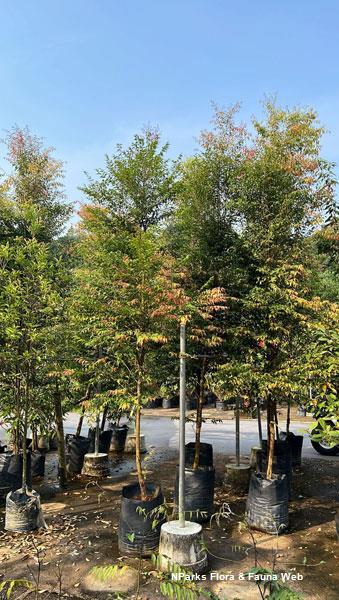_lowres.jpg)
Back
Syzygium conglomeratum (Duthie) I.M.Turner
| Family Name: | Myrtaceae |
| Synonyms: | Eugenia conglomerata Duthie |
| Common Name: | Selembat |
Syzygium conglomeratum, also known as Selembat, is a tree, once thought to be extinct in Singapore. Found in swamp forest, it stands at 27 m tall and the flowers occur in a cluster as a short fascicled spike on the older branches.
Name
Classifications and Characteristics
| Plant Division | Angiosperms (Flowering Seed Plants) |
|---|---|
| Plant Growth Form | Tree |
| Lifespan (in Singapore) | Perennial |
| Mode of Nutrition | Autotrophic |
| Plant Shape | Irregular |
| Maximum Height | 27 m |
| Tree or Palm – Trunk Diameter | 0.6 m |
Biogeography
| Native Distribution | Peninsular Malaysia and Singapore |
|---|---|
| Native Habitat | Terrestrial |
| Preferred Climate Zone | Tropical |
| Local Conservation Status | Native to Singapore (Presumed Nationally Extinct (NEx)) |
Description and Ethnobotany
| Growth Form | It is a tree, up to 27 m tall and 60 cm in girth. Buttresses can reach up to 2 m tall. The bark is reddish brown and scaly. |
|---|---|
| Foliage | Leaves are leathery, oblanceolate to narrowly obovate (5 – 10 cm long and 2 – 5.5 cm wide). The leaf tip is subacute or rounded while the leaf base is narrow (attenuate). Each leaf has 8 – 12 pairs of lateral veins which are very faintly visible and curving up to a very obscure intra-marginal nerve. The petiole is up to 1 cm long. |
| Flowers | The flowers occur in a cluster as a short fascicled spike on the older branches, below the leaves. Flowers are sessile and small. The calyx is cup-shaped (2.5 mm long) with 4 persistent lobes, and ranges from red to purple colour. Each flower has 4 white petals that are rounded and sparsely gland dotted. Stamens are white, short and numerous. Filaments are needle-like (up to 2.5 mm long) with oblong anthers at the tip. Style is short (less than 1 mm long) and 4-angled. |
| Fruit | Fruit is round (about 1 cm diameter) and slightly flattened at the top. It is berry-like, fleshy, and turns dark purplish red when ripe. The apical calyx rim is not prominent while the 4 persistent calyx lobes become incurved and fleshy. Each fruit contains one seed, about 0.5 cm diameter. |
| Habitat | It is found in swamp forest. |
| Associated Fauna | Flowers are pollinated by insects. |
| Cultivation | It can be propagated by seed. |
| Etymology | Greek syzygos, means joined, referring to the paired leaves of this species. Latin conglomeratum refers to the dense flower clusters. |
| Ethnobotanical Uses | Timber & Products: The wood is durable and used to build houses. Others: Once thought to be extinct in Singapore for many years, it is rediscovered in 2006, and the tree is recorded to be flowering and fruiting in 2021. Heritage Trees : There is currently one individual of Syzygium conglomeratum listed as a Heritage Tree in Singapore. It can be found at Mandai Night Safari. To find out more about this tree, please visit the Heritage Tree Register. |
Landscaping Features
| Landscape Uses | Reforestation, Parks & Gardens |
|---|---|
| Thematic Landscaping | Naturalistic Garden |
Fauna, Pollination and Dispersal
| Pollination Method(s) | Biotic (Fauna) |
|---|---|
| Seed or Spore Dispersal | Biotic (Fauna) |
Plant Care and Propagation
| Light Preference | Full Sun |
|---|---|
| Water Preference | Moderate Water, Lots of Water |
| Plant Growth Rate | Moderate |
| Rootzone Tolerance | Moist Soils |
Foliar
| Foliage Retention | Evergreen |
|---|---|
| Mature Foliage Colour(s) | Green |
| Mature Foliage Texture(s) | Leathery |
| Foliar Type | Simple / Unifoliate |
| Foliar Arrangement Along Stem | Opposite |
| Foliar Attachment to Stem | Petiolate |
| Foliar Shape(s) | Non-Palm Foliage (Oblanceolate, Obovate) |
| Foliar Venation | Pinnate / Net |
| Foliar Margin | Entire |
| Foliar Apex - Tip | Acute, Rounded |
| Foliar Base | Attenuate |
Non - Foliar and Storage
| Trunk Type (Non Palm) | Woody |
|---|---|
| Mature Bark Texture | Scaly |
| Stem Type & Modification | Woody |
| Root Type | Underground |
Floral (Angiosperm)
| Flower & Plant Sexuality | Bisexual Flowers , Bisexual Flowers |
| Flower Colour(s) | Cream / Off-White, Red, Purple |
|---|
| Flower Grouping | Cluster / Inflorescence |
| Flower Location | Axillary |
| Flower Symmetry | Radial |
| Individual Flower Shape | Campaulate / Bell-shaped |
| Inflorescence Type | Spike |
| Flowering Period | Rarely |
| Flowering Habit | Polycarpic |
Fruit, Seed and Spore
| Mature Fruit Colour(s) | Purple, Red |
|---|---|
| Mature Fruit Texture(s) | Glossy / Shiny |
| Fruit Classification | Simple Fruit |
| Fruit Type | |
| Seed Quantity Per Fruit | Few (1-5) |
References
| References | Henderson, M.R. (1949). The genus eugenia (Myrtaceae) in Malaya. Gardens’ Bulletin Singapore 12: 1–293. Keng, H. (1990). The Concise Flora of Singapore: Gymnosperms and Dicotyledons. Singapore: Singapore University Press. Kochummen, K.M. (1978). Myrtaceae. In: Ng, F.S.P. et al. (eds) Tree Flora of Malaya: A Manual for Foresters, vol. 3. Pp. 1–339. Kuala Lumpur: Longman Sdn. Bhd. Lemmens, R.H.M.J., Soerianegara, I., and Wong, W.C. (Editors). 1995. Plant Resources of South-East Asia Volume 5 (2). Timber Trees: Minor commercial timbers. Indonesia: Prosea Foundation. 655 pages. Ridley, H.N. (1922) The Flora of the Malay Peninsula. Vol. 1. Pp. i–912. London: L. Reeve & Co. |
|---|
Image Repository
Others
| Master ID | 33993 |
|---|---|
| Species ID | 8409 |
| Flora Disclaimer | The information in this website has been compiled from reliable sources, such as reference works on medicinal plants. It is not a substitute for medical advice or treatment and NParks does not purport to provide any medical advice. Readers should always consult his/her physician before using or consuming a plant for medicinal purposes. |

_lowres.jpg)
_lowres.jpg)
_lowres.jpg)

_lowres.jpg)
_lowres.jpg)
_lowres.jpg)

.jpg)

